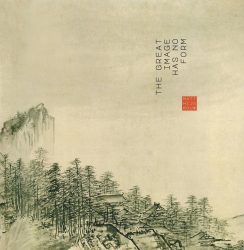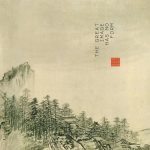MATTHIJS KOUW – THE GREAT IMAGE HAS NO FORM 
Esc.Rec (pronounce aloud) is a Dutch boutique label and platform for ‘adventurous music’. Its output is diverse, often with a strong relation to art projects, and – indeed – the best way to describe it is ‘adventurous’. Though some of their releases could be defined as ambient music, most are more ‘adventurous’ (duh) than that – ‘experimental’ is a better description. Which is why you’ll only find a small fragment of their output mentioned here. Which obviously does nót mean the other releases are not worth checking out too!
Matthijs Kouw‘s The Great Image Has No Form may very well be their most minimal ambient release to date. Kouw is a Dutch experimental musician ‘exploring the relationship between movement and stasis – combining long-form drone with elements from acousmatic music, noise and microsound’. He does so on his solo work (often as MVK), but he also explores extreme minimalist drones in collaboration with Radboud Mens.
The Great Image Has No Form was inspired by Kouw‘s visit to the Wudang Mountains in China in 2007, where he studied Chinese meditation and martial arts as a result of his long-time interest in Daoism.
“Daoism teaches us that the foundational cannot be named and identified, but rather has to be experienced firsthand”.
This is perfectly captured by the five pieces on this album, ranging between 5 and 17 minutes, dwelling in the unnamed space of complex drones – the kind of sounds for which you need a certain detached state of mind to fully appreciate them.
It is ‘minimalist’ music, but these are nót minimalist drones: a lot is happening in the deceptively static sound field which is constantly moving and shifting.
“The drones slowly coalesce, evolve, and morph into metastable structures that linger on, only to slowly evaporate and dissolve into the undifferentiated.”
The album comes in a stunningly beautiful foldout sleeve with artwork by Xia Gui, a Chinese landscape painter of the Song Dynasty who lived from 1195-1224. The beauty of this image is somewhat contradictory to the album title… The Tao that can be named is not the real Tao.
Interesting enough to reflect upon while listening to Matthijs Kouw‘s sonification of the principles of Daoism.
YANN NOVAK – STILLNESS 
In his ‘interdisciplinary work’ Yann Novak explores ‘perception, context, movement, and the felt presence of direct experience’, and seeks ‘to heighten the audience’s awareness of the present moment’. His performances and installations include ‘raw and altered field recordings, analog and digital sound synthesis, manipulated artificial and natural light, and projection, to produce slowly evolving and interrelated sonic and visual fields’.
A recording of Stillness can by definition only be a part of the project. To compensate for that, the album is released with a book with essays about the theme and photographs of three iterations of the installation. Nevertheless, it can still serve its own purpose: it is specifically mastered ‘for home listening’ by Lawrence English.
The two tracks, Stillness.Subtropical and Stillness.Oceanic, refer to the two climates that Novak has lived in: Los Angeles and Seattle, respectively:
“In these works, [Novak] investigates these climates’ almost static meteorological states and their emotional effect on their inhabitants. Constructed from numerous photographs of the horizon and shortwave radio signal tuned to static in each location, the source material is intended to capture a literal portrait of these climates. These elements are then digitally altered to create an ambiguous abstraction, leaving enough of the source to guide the experience and define the location, but abstract enough to create an immersive environment perfect for contemplation and personal reflection.”
The key word here is ‘static’: these are extremely minimalist drones – sound patterns of a complex nature that “ask us to question what can an understanding of time look like when it is not measurable, containable, or even expressible.”





